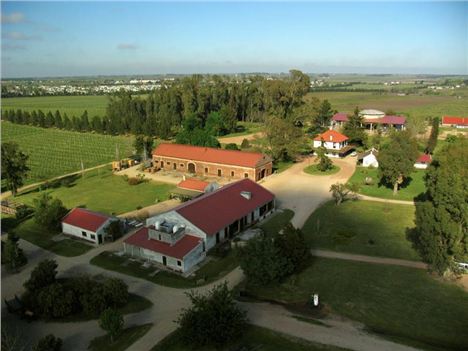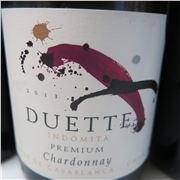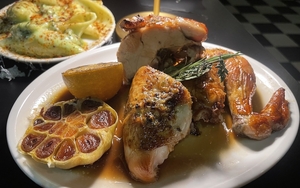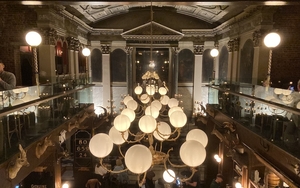MALBEC and Carmenere have their rightful places in the sun – thanks to South America and the trend towards labelling wines by the grape variety. Tannat’s time is still to come.
Lashings of cassis and chocolate, yet behind the silkiness there are firm tannins that suggest a couple of years in bottle might create an even lovelier beast
The first especially defines Argentine reds for most of us. Unfairly perhaps when Cabernet Sauvignon and Pinot Noir can also perform so well in that country. The clincher is the perception of Malbec as the perfect steak partner. Now even Cahors in South West France, where Malbec has for centuries been the staple grape for its brooding reds, labels bottles with the varietal name.
Chile’s Carmenere doesn’t trip off the tongue so easily and its passage to New World acknowledgement has been stonier. It was abandoned by Bordeaux winemakers in the 1860s, only to be given a new lease of life by the Chileans – after they finally distinguished it from Merlot. Benefiting from from ungrafted, pre-phylloxera stock, it thrives in Chile’s warmer climate. Examples vary wildly but at its best its offers soft tannins, upfront fruit, spice and a certain smokiness.
Which leads us on to a third grape yet to grab the limelight – Tannat. Like Malbec, it is associated in France with another South West AOC red – Madiran, beefier even than the Cahors of old. It produces some forthright reds in South America, mainly in little Uruguay. Not a high profile wine producer for us but, like Louis Suarez, its wines have some bite.
 The Pueblo del Sol winery in Uruguay
The Pueblo del Sol winery in Uruguay
Familia Deicas produce one in four bottles of Uruguayan wine. Their Pueblo del Sol Tannat 2013 (£8.49, available soon in Manchester, I’ll keep you posted) is a more accessible, fruity example. Hints of chocolate and cherry on the nose lead into smooth, tart plum and spice flavours.
 Uruguay’s whites I’m less familiar with, but I was impressed by Juanicó Benteveo Chardonnay 2014, just 12.5 per cent, unoaked and awash with fresh pear and apple. Simple and appealing, it costs £6.95 on special offer from the Wine Society until March 9. In the same South American offer try the equally affordable, at £6.50, Cono Sur Los Gansos Merlot 2013 – fresh, spicy merlot, with a dash of Cabernet for structure with five per cent aged in barrels. Named after the geese (gansos) that roam the vineyards eating insects and other pests. The Wine Society are also doing special mixed cases showing their South American range.
Uruguay’s whites I’m less familiar with, but I was impressed by Juanicó Benteveo Chardonnay 2014, just 12.5 per cent, unoaked and awash with fresh pear and apple. Simple and appealing, it costs £6.95 on special offer from the Wine Society until March 9. In the same South American offer try the equally affordable, at £6.50, Cono Sur Los Gansos Merlot 2013 – fresh, spicy merlot, with a dash of Cabernet for structure with five per cent aged in barrels. Named after the geese (gansos) that roam the vineyards eating insects and other pests. The Wine Society are also doing special mixed cases showing their South American range.
Nearer home, Reserve Wines of West Disbury also have several of their South American favourites on special offer until the end of February.
I loved their Espiritu de Chile Carmenere 2011 (down from £9.50 to £7.50). Smooth almost creamy blueberry fruit, coffee and vanilla on the finish from oak aging, it is dangerously drinkable. It’s labelled Riserva Privada. Chilean and Argentine wines are full of such impressive names for which there are no official criteria. Unlike, say, Rioja in Spain.
 Another Reserve Wines Chilean (not on offer), Duetta, 2011 Chardonnay (£11.50,) is a ‘Premium Range’ white from Indomita in the Casablanca Vallley ). Ripe pear and melon on the nose, creamy on the palate, its hint of sweetness is countered by fresh acidity while, from Argentina’s Mendoza region, Sottano Seleccion del Enologo Cabernet Sauvignon 2009 (£19.99) wears its eco credentials on its label – 'Our wines are a result of our respect and collaboration with Mother Nature' In this case, Mother Nature and some canny winemaking, have done them proud. This special selection has benefited from 12 months in new oak, 70 per cent French, 30 per cent American – so you get an inky colour in the glass, lashings of cassis and chocolate, yet behind the silkiness there are firm tannins that suggest a couple of years in bottle might create an even lovelier beast.
Another Reserve Wines Chilean (not on offer), Duetta, 2011 Chardonnay (£11.50,) is a ‘Premium Range’ white from Indomita in the Casablanca Vallley ). Ripe pear and melon on the nose, creamy on the palate, its hint of sweetness is countered by fresh acidity while, from Argentina’s Mendoza region, Sottano Seleccion del Enologo Cabernet Sauvignon 2009 (£19.99) wears its eco credentials on its label – 'Our wines are a result of our respect and collaboration with Mother Nature' In this case, Mother Nature and some canny winemaking, have done them proud. This special selection has benefited from 12 months in new oak, 70 per cent French, 30 per cent American – so you get an inky colour in the glass, lashings of cassis and chocolate, yet behind the silkiness there are firm tannins that suggest a couple of years in bottle might create an even lovelier beast.
Among the wines on special offer at the Co-operative from February 25 until March 17 is a trio of good value South American wines, two from Chile, one from Argentina.
Montes Reserve Sauvignon Blanc 2013 from Chile's Curico Valley (£8.79 to £6.79)
A lovely lemon-lime, tropical fruit refresher with cut-grass and herbs on the nose.
Casillero Diablo Carmenere 2012 (£7.99 to £5.99)
Velvety smooth from nine months’ aging in American oak, it is plummy and spicy, though lacking the complexity of the Espiritu de Chile.
Trapiche Pure Malbec 2013 (£8.99 to £6.99)
Spicy nose, juicy tannins and an underlying earthiness. Good for the reduced price, but a better Malbec bet from them, with oodles of chocolate, cherry and vanilla, is the Co-operative Fairtrade Truly Irresistible Malbec 2013. which costs £7.49 instead of its usual £8.49 throughout Free Trade Fortnight (February 24-March 9).
Since launching the first Fairtrade wine in 2004, the Co-op range has helped to launch many projects across the world to offer vital resources such as education, health and cleaning running water to communities in developing countries. The Co-op also works closely with producers to blend the wines. For more information visit this link.















